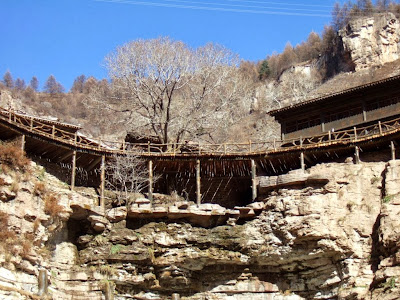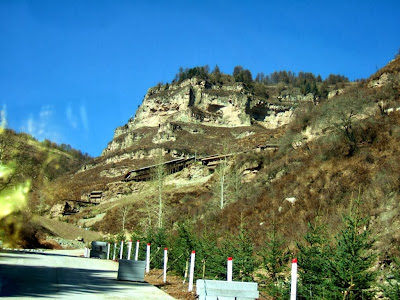
The isolated suspended village at the slope of Mountain Guancen-shan (管涔山) in Ningwu County that leans against a precipice over looking a valley, is officially named as Village of Wanghuagou-cun (王化沟村). The history dated to about 200 years ago during the reign of Emperor Qianlong in Qing Dynasty. It was believed that the ancestors of the villagers moved and settled down at this mountainous remote site were most probably to avoid certain catastrophe or run away from war crisis.


The number of families staying here in its peak period was more than hundreds of them. But due to its inconveniences, many had shifted to flatland especially those youngsters who are looking for a better life. Residents still live here are mainly aged or senior people.


It was quite interesting to visit the village but was rather tough to climb up a steep slope and go along with a winding and narrow pathway.


The weather of this mountainous village site is comparatively cold. The winter season starts early. When snow begins to cover the site, it would be a very hard job for most outsiders to ascend up the village.













Looking up from the slope, one only can see how line of structures built against the overhanging cliff in accordance with its landscape.



The front part of the buildings were supported and suspended by the wood column as pillars while creating a safe angle against the slope of the cliff at its back.


The vertical supporting columns are in fact the original wood logs obtained from the mountain.

















There is a natural well at the side of the village, in a sheltered hut specially built by the villagers to protect the only source of their drinking water. The hut was pasted with red papers written with complimentary phrases and couplets.


The villagers said that it was the well that attracted their ancestors to settle down at this village.




The water in the well, so far, never dried up or reduced. It is always full and sometimes overflowing too. The well situated just against the cliff and nobody can ever tell where and how the source of water comes from.







There is only one street in the village and it was built with the chopped down tree trunk symmetrically laid in row one after another with vertical support from the upright column of the original wood logs from the bottom.


The walking street appears as if a black dragon curling at mountain slope when looking up from the valley, but if viewed down from hill top, it looks like a twirling belt circling the mountain.





Villagers made full usage of the existing convenient sources to build up their living quarters. Houses were built with wood and stone while walking way and rail were made with original wood logs and twigs.






Various designs of the village houses that used and applied different existing building materials.





Brick slabs and metal wired windows began to apply in this new row of settlement.


Couplets with phrases of fortune and luck, are found at the doors of almost all houses.



Villagers at this moment, still lead a tradition and simple life. Every day before daily routine life starts, to manually carry water back from the well is the first and priority work of each family in the morning.



Animal carriages are the important transportation that assist them to obtain their daily needs. Many families rear domestic animals especially goats, sheep, horses, pigs and fowls.







He tried to capture and keep its primitive look before it develops and turns into a hot touristic attraction.


The stunning mountain view in front of the village.


A last glimpse of the unique hanging village.



No comments:
Post a Comment